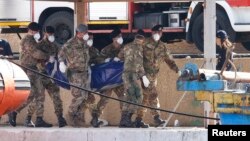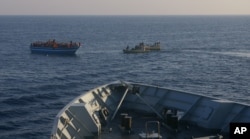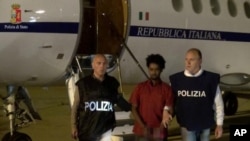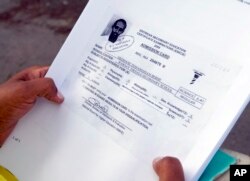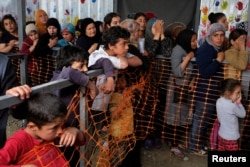On October 3, 2013, hundreds of African migrants desperate to reach Europe died less than 400 meters from reaching their goal.
With the Italian island of Lampedusa in sight, the migrants’ rickety, overcrowded boat began to sink. They set a blanket on fire to signal for help, but flames engulfed the ship. The passengers crowded to one side, and the vessel capsized.
The official death toll was 368, according to the International Organization for Migration. Others remain missing and most likely drowned. Those rescued live with emotional and physical scars, not only from the sinking but also from the trip itself, because many were raped or tortured by traffickers.
In the wake of the Lampedusa tragedy, European authorities set out to crack down on the smugglers and traffickers who sent the migrants to their deaths. They determined that a vast, organized and well-funded network fuels much of the migration out of Africa and the Middle East. For three years, officials from Italy, Britain and other countries have investigated the network behind the Mediterranean migration crisis.
Despite a coordinated international approach, millions of dollars spent and untold man hours, the impact of efforts to thwart the smuggling rings remains unclear. Dozens have been arrested and face prosecution. Officials have wiretapped hundreds of calls and mapped the scope of the trafficking networks across continents.
But the death toll in the Mediterranean is on track to rise for the third straight year, with at least 10,000 additional migrant deaths recorded in the Mediterranean Sea since Lampedusa. Three wrecks in June 2016 alone may have led to 700 deaths, according to the U.N. refugee agency and IOM.
Tens of thousands of refugees arrive on European shores each month. And at least one high-profile case has raised questions about the methods investigators use to find their targets.
Initial successes
Calogero "Gery" Ferrara, an Italian justice department prosecutor in Palermo, said his team identified key figures in a large network of traffickers and smugglers early in their investigation. One breakthrough came in 2014 when Nuredin Wehabrebi Atta, an Eritrean smuggler, was arrested and agreed to assist authorities as a whistle-blower in exchange for protection.
Atta painted a gruesome picture of the system, saying traffickers often held would-be migrants hostage and extorted their families for money under threat of death to their loved ones.
Migrants who didn’t have or couldn’t get enough money to pay their ransom, he said, were subject to organ trafficking or sold for about $16,000, effectively turning them into slaves. He outlined a wide-reaching network that included arms and drug smugglers.
More arrests followed. On July 4, 2016, Italian authorities arrested 25 Eritreans, 12 Ethiopians and an Italian thought to be involved in smuggling after a raid on a perfume shop in Italy. Over 526,000 euros (about $578,000) and $25,000 in cash were discovered in the raid. Authorities also found an address book that contained names of smugglers, according to Reuters.
However, Ferrara said the investigation, code-named Glauco, was fraught with challenges from the beginning. Trafficking networks are vast and difficult to infiltrate. Smugglers go to great lengths to conceal money transfers. Investigators often must work from a distance, retracing routes from clues that migrants bring when they land in Europe.
Even migrants’ departure points can be difficult to identify.
“They have a very structured organization — [a] very well-organized criminal association with a clear division of roles,” he said.
Big break or mistaken identity?
This past May, authorities from Italy and Britain found an individual whom they believed to be a smuggling kingpin in El Diem, an area in Sudan’s capital, Khartoum. El Diem is a popular spot for migrants to play pool and drink tea and coffee. At a small coffeehouse called Diem, Sudanese authorities apprehended Medhane Tesfamariam Berhe of Eritrea and extradited him to Italy.
Italian and British authorities hailed it as the big break they had spent over a year looking for, but it may be a case of mistaken identity that demonstrates the difficulty of dismantling trafficking networks.
Following the arrest, family members and journalists questioned whether authorities had the right person. Victims of the actual trafficker testified in court that authorities had arrested the wrong man. Friends in Sudan who knew Berhe insisted that authorities had the wrong person.
The confusion began with the name. Eritrean names follow a paternal line, and the suspect extradited to Europe shares only the first, or given, name with the wanted criminal, whom authorities initially identified as Medhane Yehdego Mered. This kingpin is suspected of killing and torturing many migrants.
By one account, he controlled 4 percent of the human trafficking into Italy.
Michele Calantropo, the Italian lawyer of Medhane Tesfamariam Berhe, said that confusion about the name isn’t the only reason his client should be released. A photo used by prosecutors and circulated around the world via social media did not match the man who was extradited, he said.
Despite these discrepancies, authorities insist they have the right person, although they now admit to mistakes, including misidentifying the suspect’s name and distributing the wrong photo, according to Reuters. Medhane Tesfamariam Berhe is the name of the ringleader, not Medhane Yehdego Mered, they say. And the photo that circulated in the media, online and in the prosecution’s own presentation materials is of a different, unrelated person.
Ferrara, however, maintains they have the right person.
“He was operating in Sudan and Libya, so we never saw him. We don’t know his face, but we have 12,000 conversations regarding, concerning him,” Ferrara said.
Medhane Tesfamariam Berhe’s lawyer sees it differently.
“It’s very strange that before it was a good photo and now it’s not,” Calantropo said in reaction to the prosecutor’s dismissal of the image.
At a recent closed hearing, authorities presented additional physical evidence. The phone in possession of the individual they apprehended in Khartoum had been used to log in to the same Facebook account and call the same numbers as the person they had been investigating since 2014, prosecutors asserted.
Journey's cost
Human trafficking and smuggling is a lucrative business. Migrants and refugees spend over $1.1 billion a year, according to The Migrants' Files, a consortium of journalists from 10 European countries. Beyond risking inhumane treatment and jeopardizing their lives, migrants pay smugglers and traffickers large sums of money, often at multiple points in their journeys.
Most migrants crossing the Mediterranean pay between $5,500 (to travel overland through Turkey and into Europe) to $18,700 (to board a flight, depending on the destination), a spokesperson for Britain’s National Crime Agency told VOA.
But the NCA said that there are also times when smugglers lower prices to entice migrants to board ships in bad weather.
Whether or not migrants can make good on their payments, smugglers and traffickers find ways to profit. Amanuel Zaid, an Eritrean living in Virginia, knew the extradited Medhane in Sudan and made observations on smuggling networks during his time in Khartoum.
Smugglers based in the Sudanese capital have their own employees across countries in the region, he said. When migrants enter Sudan from places like Ethiopia and Eritrea, smugglers take them to a checkpoint called Hajer to determine who has paid the full amount before letting them pass. Those who have not paid are handed off to be sold as commodities.
From Eritrea to Sudan, for example, safe passage could cost between $6,000 and $7,500, Zaid said, but there are additional costs to continue on from Sudan to Libya that could total about $1,600.
Countries cooperate
The NCA collaborates with regional governments such as Greece to stop smugglers through its Invigor operation. It has contributed to the interception of boats en route to Libya with weapons, ammunition and smuggled cigarettes, according to a statement from the spokesperson. Some of these boats are used to transport migrants when returning back, the statement said.
Sudanese authorities also say they are eager to help dismantle trafficking networks.
Mekki Elmograbi, the media representative of the Sudanese Embassy in Washington, says that his government is working with the European Union to bridge gaps and improve the international prosecution system.
“The level of understanding between the Sudanese government and the European Union and European countries has reached a very advanced level,” he said.
The European Commission recently announced a $110 million aid package for Sudan to address the “root causes of irregular migration and forced displacement” in places including Darfur, East Sudan, and the states of Southern Kordofan and Blue Nile — all areas ravaged by war over the last decade.
Elmograbi said there are more than 15 smuggling gangs operating in the region.
“There is sometimes a kind of cooperation between gang to gang so that they take the immigrants from here and bring them to another country. So they are acting just like authorities receiving money from people and sometimes abandoning people in the desert, letting them to die, or even in the sea,” he said.
Ringleaders at large
Medhane Tesfamariam Berhe, meanwhile, remains in prison in Italy. When Sudanese authorities arrested him, they took all his identification documents and didn’t hand them over to Italian or British authorities, said his lawyer, Calantropo. To fill biographical details, Calantropo collected documentation from his family.
His sister, Seghen Berhe, told VOA that he was born in 1987 in the neighborhood of Geza Banda Tilian in Eritrea’s capital, Asmara. He attended Isak Teweldemedhin Secondary School and underwent military training in Sawa. Like many youth who feel trapped by Eritrea’s system of mandatory national service, he fled to Ethiopia and entered the Hitsats refugee camp in April 2014, his sister said.
During his first hearing on July 4, victims tortured by the criminal who shares his name explained their encounters and confirmed to authorities that they had the wrong person. At another hearing this month, it was ruled that he should remain behind bars until his next court date on September 20. His lawyer’s petition for his release was denied.
All the while, Calantropo said, the real criminal remains at large in Libya, where he has been since 2015.




